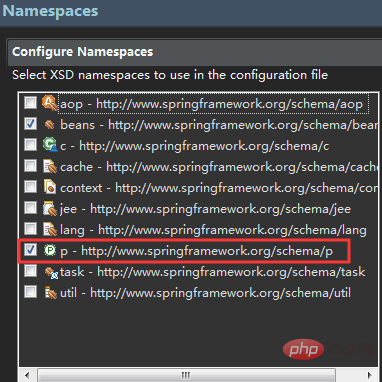How to implement dependency injection in java Spring

Generally speaking, there are three ways of dependency injection in Spring:
① Assignment through set
②Assign value through constructor
③Assign value through p tag
Recommended java related video tutorials: java video
Let’s expand on the discussion a little bit:
1. Assign value through set method
<bean id="teacher" class="org.szh.entity.Teacher" p:age="24" p:name="lq"> <property name="name" value="zs"></property> <property name="age" value="23"></property> </bean>
Mainly use
The name here is the variable name declared in the Teacher class, and the value is the value you want to assign to this variable.
Teacher class:
public class Teacher {
private String name;
private int age;
public Teacher() {
}
public Teacher(String name, int age) {
this.name = name;
this.age = age;
}
public String getName() {
return name;
}
public void setName(String name) {
this.name = name;
}
public int getAge() {
return age;
}
public void setAge(int age) {
this.age = age;
}
}2. Assign value through constructor
<bean id="teacher" class="org.szh.entity.Teacher"> <constructor-arg value="zs" ></constructor-arg> <constructor-arg value="24" ></constructor-arg> </bean>
Note that there must be a corresponding constructor method in the above Teacher class.
If there are many values in the parameter list in the constructor, it will be very tiring for us to write them one by one. At this time, there are several ways to help us accurately assign values to variables:
1. Use index (subscript value)
2.name (name of declared variable)
3.type (type of declared variable) // The type declared in the parameter list of the constructor is required You can pass the value if it is inconsistent
The specific format is as follows:
<constructor-arg value="zs" 你要用来做辨认的属性(index/name/type)="..."></constructor-arg> <constructor-arg value="24" 你要用来做辨认的属性(index/name/type)="..."></constructor-arg>
There is another point to note here: if you want to pass a reference within the tag Type, you cannot use value, you have to use ref:
<constructor-arg ref="teacher"></constructor-arg>
3. Assign value through p tag
You need to pay attention here, if your compiler does not If you install sts, you need to add this sentence to the configuration statement of your applicationContext.xml:
xmlns:p="http://www.springframework.org/schema/p"
If you have installed sts, just check it directly in Namespaces:

The specific writing method is as follows:
<bean id="teacher" class="org.szh.entity.Teacher" p:age="24" p:name="lq"> </bean>
Just add p:xxx="xxx" in the tag.
Recommended java related articles and tutorials: java introductory tutorial
The above is the detailed content of How to implement dependency injection in java Spring. For more information, please follow other related articles on the PHP Chinese website!

Hot AI Tools

Undresser.AI Undress
AI-powered app for creating realistic nude photos

AI Clothes Remover
Online AI tool for removing clothes from photos.

Undress AI Tool
Undress images for free

Clothoff.io
AI clothes remover

Video Face Swap
Swap faces in any video effortlessly with our completely free AI face swap tool!

Hot Article

Hot Tools

Notepad++7.3.1
Easy-to-use and free code editor

SublimeText3 Chinese version
Chinese version, very easy to use

Zend Studio 13.0.1
Powerful PHP integrated development environment

Dreamweaver CS6
Visual web development tools

SublimeText3 Mac version
God-level code editing software (SublimeText3)

Hot Topics
 1392
1392
 52
52
 Perfect Number in Java
Aug 30, 2024 pm 04:28 PM
Perfect Number in Java
Aug 30, 2024 pm 04:28 PM
Guide to Perfect Number in Java. Here we discuss the Definition, How to check Perfect number in Java?, examples with code implementation.
 Weka in Java
Aug 30, 2024 pm 04:28 PM
Weka in Java
Aug 30, 2024 pm 04:28 PM
Guide to Weka in Java. Here we discuss the Introduction, how to use weka java, the type of platform, and advantages with examples.
 Smith Number in Java
Aug 30, 2024 pm 04:28 PM
Smith Number in Java
Aug 30, 2024 pm 04:28 PM
Guide to Smith Number in Java. Here we discuss the Definition, How to check smith number in Java? example with code implementation.
 Java Spring Interview Questions
Aug 30, 2024 pm 04:29 PM
Java Spring Interview Questions
Aug 30, 2024 pm 04:29 PM
In this article, we have kept the most asked Java Spring Interview Questions with their detailed answers. So that you can crack the interview.
 Break or return from Java 8 stream forEach?
Feb 07, 2025 pm 12:09 PM
Break or return from Java 8 stream forEach?
Feb 07, 2025 pm 12:09 PM
Java 8 introduces the Stream API, providing a powerful and expressive way to process data collections. However, a common question when using Stream is: How to break or return from a forEach operation? Traditional loops allow for early interruption or return, but Stream's forEach method does not directly support this method. This article will explain the reasons and explore alternative methods for implementing premature termination in Stream processing systems. Further reading: Java Stream API improvements Understand Stream forEach The forEach method is a terminal operation that performs one operation on each element in the Stream. Its design intention is
 TimeStamp to Date in Java
Aug 30, 2024 pm 04:28 PM
TimeStamp to Date in Java
Aug 30, 2024 pm 04:28 PM
Guide to TimeStamp to Date in Java. Here we also discuss the introduction and how to convert timestamp to date in java along with examples.
 Explain the concept of Dependency Injection (DI) in PHP.
Apr 05, 2025 am 12:07 AM
Explain the concept of Dependency Injection (DI) in PHP.
Apr 05, 2025 am 12:07 AM
The core value of using dependency injection (DI) in PHP lies in the implementation of a loosely coupled system architecture. DI reduces direct dependencies between classes by providing dependencies externally, improving code testability and flexibility. When using DI, you can inject dependencies through constructors, set-point methods, or interfaces, and manage object lifecycles and dependencies in combination with IoC containers.
 Java Program to Find the Volume of Capsule
Feb 07, 2025 am 11:37 AM
Java Program to Find the Volume of Capsule
Feb 07, 2025 am 11:37 AM
Capsules are three-dimensional geometric figures, composed of a cylinder and a hemisphere at both ends. The volume of the capsule can be calculated by adding the volume of the cylinder and the volume of the hemisphere at both ends. This tutorial will discuss how to calculate the volume of a given capsule in Java using different methods. Capsule volume formula The formula for capsule volume is as follows: Capsule volume = Cylindrical volume Volume Two hemisphere volume in, r: The radius of the hemisphere. h: The height of the cylinder (excluding the hemisphere). Example 1 enter Radius = 5 units Height = 10 units Output Volume = 1570.8 cubic units explain Calculate volume using formula: Volume = π × r2 × h (4




